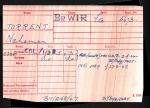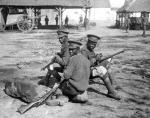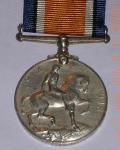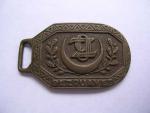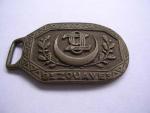-
Posts
3,687 -
Joined
-
Last visited
-
Days Won
2
Content Type
Profiles
Forums
Blogs
Gallery
Events
Store
Everything posted by Tony
-
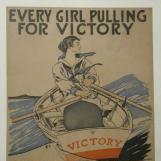
French reproduction British Victory medal
Tony replied to RobW's topic in Great Britain: Orders, Gallantry, Campaign Medals
A ball suspender would be the give away for noticing it's a French made VM. I would think there are other details too. Perhaps the British VM in the 1934 book is a simple mistake by the author who may not have known the suspender is barrel shaped. As for the mini, I have no suggestions, sorry. Tony -

ID tag-WWI
Tony replied to Karsten S's topic in Germany: Imperial Uniforms, Headwear, Insignia & Personal Equipment
Chip, Why a 1915 draft class? Were they called up at 20 years of age if they hadn't already volunteered? Cheers Tony -

swb to the royal navy roll
Tony replied to a topic in Great Britain: Research, Documentation & History
Mine also starts with a 2 Tony -

Camo Helmet
Tony replied to Chris Boonzaier's topic in Germany: Imperial Uniforms, Headwear, Insignia & Personal Equipment
Would you believe I sold my one over 10 years ago for a whole 100 GBP to a dealer and even though it was missing its liner, I know I really should have kept it. Tony -

A difficult preservation task...
Tony replied to Chris Boonzaier's topic in Preservation & Restoration of Military Artifacts
Have you looked into the possibility of using a de-acidification spray? It's supposed to work on old books and you have a ton of those you you wouldn't be buying it for nothing. I haven't used any myself so can't say if it's good, hard to come by, cheap or expensive but if it preserves your goodies I wouldn't worry too much about the cost. Tony -

EK 1914 Fantastic ugly historical EK doc...
Tony replied to Chris Boonzaier's topic in Germany: All Eras: The Iron Cross
Sounds a bit like Gommecourt on the Somme. Hurry up and research him and his unit then and post it Tony -

Defence & War Medal question
Tony replied to Tony's topic in Great Britain: Orders, Gallantry, Campaign Medals
Thanks for the reply. I don't suppose we'll ever know why and I don't suppose many people care too much either. Tony -

EK 1914 Fantastic ugly historical EK doc...
Tony replied to Chris Boonzaier's topic in Germany: All Eras: The Iron Cross
I thought Passchendaele took place a few km north of Wytschaete or White Sheet. I know the wife's grandad was in the Wytschaete Bogen when the mines were blown on the Menin Ridge in June 1917 and I also know he was wounded in October during 3rd Ypres but have no idea if his unit was still in the Wytshaete area or nearer to Passchendaele. A nice piece of paper to have though. By the way, I've just sold a memorial plaque to an AIF man who died of wounds in October 17 in the Ypres salient, I wonder if your MGSS was responsible for the gunshot wound to the abdomen. Tony -
That's great. It's amazing it didn't get lost or damaged over the last couple of hundred years. It reminded me of the rhyme - for want of a nail the shoe was lost. Tony
-
Joe, A bit off the topic of the photos but have a look at posts 82 and 83 here regarding the 7ft soldier http://gmic.co.uk/index.php?showtopic=3078...mp;#entry122963 Tony
-

British West Indies Regt. 1914-18
Tony replied to Tony's topic in Great Britain: Orders, Gallantry, Campaign Medals
I bought another British War Medal to a member of the British West Indies Regiment recently, who, according to the CWGC died in Marseilles just two weeks before the armistice. I don't know how he died whether from illness, wounds, by accident etc. as ORs of the Br.W.I.R. don't appear on the soldiers died cd. His unit may have been at rest in Marseilles or possibly on the way to Italy where the BWIR was used for labouring duties. I've not been able to find anything (online) on Pte. E. Sinclair apart from his MIC. Elizah Sinclair was a member of the 3rd Infantry Battalion Br.W.I.R. The 3rd Battlion left for England in January 1916 and landed in France in July 1916, where, going by their battle honours alone, they spent the next couple of years in Belgium (Messines 1917, Ypres 1917, Polygon Wood, Broodseinde, Poelcappelle, Passchendaele, Pursuit to Mons) although one of the photos posted above shows men from the regiment on the Somme. The British West Indies Regt. was also sent to East Africa, Egypt, Palestine, Jordan, France and Italy. Does anyone have an idea of the value of medals to the Br.W.I.R.? Tony -

British West Indies Regt. 1914-18
Tony replied to Tony's topic in Great Britain: Orders, Gallantry, Campaign Medals
Nice one Leigh. Tony -

British West Indies Regt. 1914-18
Tony replied to Tony's topic in Great Britain: Orders, Gallantry, Campaign Medals
Peter, It makes a simple named medal very interesting doesn't it. Towards the end of the war British Troops were given a 50% pay rise but the War Office denied the West Indian troops this payment. This was latter reversed by the Colonial Office who feared the resentment it caused would result in violence on their return home after demobilisation. Another policy was that black troops had to have white Officers, this limited the promotion prospects of West Indians to the rank of sergeant. After the war, the battalions who were serving in France and Egypt were moved to Taranto, Italy, to join their comrades already there. Again they were used as "labour" battalions. On the 6th December 1918 members of the 9th Battalion attacked there officers due to their poor treatment. More incidents of of insubordination followed as the troops refused to carry out duties that were assigned to them. On 17th December 1918, about 60 sergeants formed the "Caribbean League" and one of their demands was that "the black man should have freedom to govern himself". The league was betrayed to Officers and it was disbanded early in 1919. Some soldiers were accused of mutiny and received sentences of between 3 and 5 years in prison. One man was sentenced to 20 years and another was executed by firing squad. The authorities then made the decision to disarm the the soldiers and disband the BWIR as soon as possible. The fear then was that the demobbed soldiers would promote disorder on return back to the West Indies. Some disturbances did take place and were lead by demobilised soldiers, but on the whole an uneasy truce had broken out. Even the wounded and disabled. Wounded BWIR soldiers were not spared prejudice and discrimination. In the Autumn of 1918 about 50 members of the B.W.I.R. were being treated at Belmont Road Military Auxiliary Hospital, Liverpool. All had been seriously injured and had suffered wounds which had resulted in foot or leg amputations. Relations between black and white soldiers were good at first until some South African causalities were brought in. They soon began to taunt and insult the B.W.I.R. soldiers. As relations deteriorated fighting broke out between the two groups. Problems occurred after the war had ended with pensions. See the following example of Private Pte. A. Francis who had lost an arm during active service. "Francis, a coloured man who worked in the shipyard at Liverpool, volunteered under the Derby Scheme and, because "great difficulty was found in posting men of colour to ordinary British units", he was posted to the B.W.I.R., which had been set up expressly to cater for his and similar cases. Upon his being invalided out after the loss of an arm, he was granted a pension considerably lower than that to which he would have been entitled had he been assigned to an ordinary British line regiment. The Treasury was unwilling to open the door to revising the principle of differential rates but it did give the department the "loophole" of granting him an alternative pension at the "European" rate." Though living, working and fighting for Britain during the war he was not considered "British" by the army on volunteering or by government departments for a pension. Ref: PRO document: T 1/12482 Graham, The joys of remembering I have a copy of The Researchers Guide to the Great War were dampened by the fact I forgot I have it. Could returned undelivered possibly be Retd. (uncl.) returned unclaimed? IVB 1084 of 27.8.47 being the Issue Voucher for the reissue. Tony -

swb to the royal navy roll
Tony replied to a topic in Great Britain: Research, Documentation & History
Joe, I've been searching for this thread for ages, well done for finding it and bringing it back to the top. I just have to find my badge and check the number on it. Rick, the SWB is the Silver War Badge (commonly wrongly called the Silver Wound Badge), it was a badge issued to members of Empire forces who were invalided out due to sickness or wounds. They didn't have to have been taken on strength of a unit already in theatre beforehand. E.g my g grandad was ill while still in England in 1915, invalided out, would have received his badge some time after 1916 but he then joined up again and went to France in 1918 so, it wasn't an ultimate discharge. He also received the WWII version (cheap and nasty looking compared to the Great War badge in my opinion) for being wounded at Dunkirk. http://en.wikipedia.org/wiki/Silver_War_Badge_(SWB) Here's an (privately done) enamelled version I bought a while back http://gmic.co.uk/index.php?showtopic=29138&hl=allibone and here's one too http://gmic.co.uk/index.php?showtopic=28063&hl=swb* There are also a few photos of them being worn in the 'wounded' thread. Tony -

British West Indies Regt. 1914-18
Tony replied to Tony's topic in Great Britain: Orders, Gallantry, Campaign Medals
Thanks to you both for having a look. It's a great pity that service records to the BWIR were destroyed by the Luftwaffe. I don't think this unit is very collectable but I find it interesting that blokes from the West Indies got up and volunteered for a war so far away from their home. I can only imagine they must have felt a strong allegiance to the Empire. Tony -

British West Indies Regt. 1914-18
Tony replied to Tony's topic in Great Britain: Orders, Gallantry, Campaign Medals
-

British West Indies Regt. 1914-18
Tony replied to Tony's topic in Great Britain: Orders, Gallantry, Campaign Medals
I've just noticed there seems to be a lack or cap badges being worn. From http://website.lineone.net/~bwir/bwi_regt.htm A total of 397 officers and 15,204 other ranks served in the BWIR. 185 killed or died of wounds, 697 wounded and 1,071 died due to sickness. Many of the wounded were moved back to Military Hospitals in Britain for treatment. The site doesn't have a great deal of information regarding the Great War, in spite of this, it makes an interesting read with some details regarding the poor treatment of coloured soldiers and their post armistice mutiny. If anyone has the book titled Jamaican Volunteers in the First World War and wants to 'give' it to me, I'd be very happy to take it ;) -

British West Indies Regt. 1914-18
Tony replied to Tony's topic in Great Britain: Orders, Gallantry, Campaign Medals
-

British West Indies Regt. 1914-18
Tony replied to Tony's topic in Great Britain: Orders, Gallantry, Campaign Medals
Pte. Nahaman Torrent's unit, probably the 4th Battalion (only an assumption as his number appears to indicate he came from Jamaica and 66% of the volunteers were Jamaican), was raised in May 1916 and landed in France in July 1916. Nahaman Torrent survived the war and who knows, he may well have been one of the mutineers. The picture below was taken in Albert, on the Amien Road in September 1916. See this site http://commons.wikimedia.org/wiki/File:Bri...jpg#filehistory -
I bought this BWM to a member of the British West Indies Regt. but am unable to find hardly any details about the unit so if anyone can help me, please do. The limited research I have at present was found online and passed on by the previous owner of the medal. It looks to have been cleaned recently, I hope the dullness will disappear after a soapy water clean. Tony
-
That was at Monchy Joe and must have been at the very least 5 years ago now. Tony
-
It's good to hear they were able to restore many of the plates. Great photos showing a variety of what was worn in France in 1915 and 16 I'd guess, with British, French, Canadian and Australian soldiers. A pity they remain unknown. Tony
-
Hello, Can anyone please tell me what this is? It's quite small, about 3cm long and the reverse is blank. Thanks Tony
-

RORKE'S DRIFT SHIELD - 1879
Tony replied to Mervyn Mitton's topic in Great Britain: Militaria: Badges, Uniforms & Equipment
Just fantastic, please keep the posts coming. Tony





